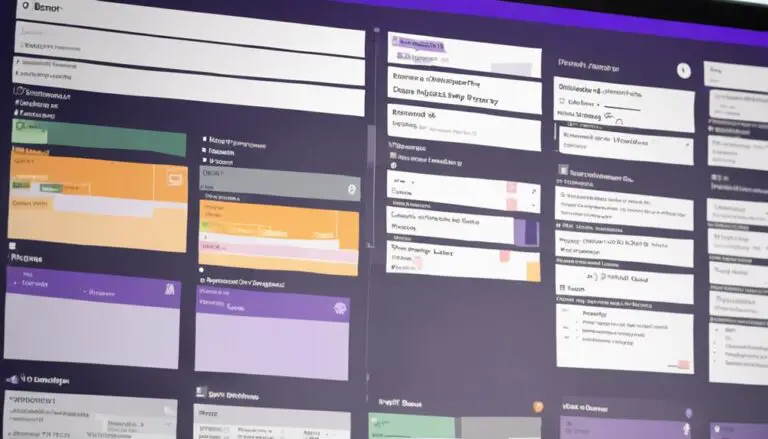Imagine you're embarking on a journey without a map; it would be challenging to reach your destination efficiently. Similarly, in the world of Kanban teams, setting clear iteration goals acts as your guiding compass.
These goals not only steer your team towards success but also pave the way for improved collaboration and productivity.
But, do Kanban teams truly prioritize the publication of these crucial goals for their success, or is there more to uncover beneath the surface?
Key Takeaways
- Clear iteration goals are essential for maximizing efficiency and productivity in Kanban teams.
- Establishing shared focus and direction enhances team alignment and collaboration.
- Defined goals significantly improve project outcomes by enabling effective work prioritization.
- Communication and collaboration are key for achieving goals and ensuring success in Kanban teams.
Importance of Clear Iteration Goals
To maximize efficiency and productivity within your Kanban team, having clear and well-defined iteration goals is essential. These goals serve as a roadmap for your team, guiding them towards success with a shared understanding of what needs to be achieved. One way to ensure your team stays on track is by utilizing a website which helps you analyze and track visitors. By setting clear iteration goals, you can meet the objectives of each sprint effectively.
Having well-defined goals not only improves your experience but also helps in delivering a better user experience to your customers. By understanding and analyzing the data provided by tracking functionalities, you can enhance your team's performance. These clear iteration goals enable you to perform certain functionalities like sharing progress updates and ensuring alignment within the team. Overall, setting clear iteration goals is the first step towards achieving success and fostering a collaborative environment within your Kanban team.
Enhancing Team Productivity Through Goals
Enhance your Kanban team's productivity by establishing clear iteration goals that provide a shared focus and direction for achieving success collaboratively. Setting specific and measurable goals in Kanban not only improves team alignment but also enhances collaboration and accountability within the team. By defining these iteration goals, your team gains a clear understanding of what needs to be accomplished, fostering a sense of purpose and direction in their work. This shared focus ensures that everyone is working towards the same objectives, minimizing confusion and maximizing efficiency.
Moreover, iteration goals enable your Kanban team to prioritize work effectively, reduce waste, and consistently deliver value. As these goals are transparent and well-communicated, they facilitate better decision-making, communication, and adaptability to changes. Embracing clear iteration goals supports continuous improvement, learning, and the achievement of sustainable performance, creating a culture of success within your team. By embracing this approach, your team can work together seamlessly towards common objectives, driving productivity and success collaboratively.
Impact on Project Outcomes
Improving project outcomes significantly relies on the establishment of clear iteration goals within Kanban teams to provide focus, direction, and alignment towards achieving specific objectives.
By defining these iteration goals, Kanban teams set a clear path for their work, enabling them to prioritize effectively, manage dependencies efficiently, and consistently deliver value. The visibility and transparency that come with publishing these goals promote accountability within the team, fostering a culture of continuous improvement.
Measurable goals not only allow teams to track progress but also to identify bottlenecks and make informed decisions to optimize workflow. The impact of setting clear iteration goals is evident in reduced lead times, increased efficiency, and the team's ability to adapt swiftly to changing requirements, ultimately leading to successful project outcomes.
Embracing this approach ensures that every team member understands their role in achieving shared objectives, driving collective efforts towards project success.
Strategies for Goal Clarity Improvement
Consider utilizing a structured approach to enhance the clarity of your team's goals within the Kanban framework. Start by defining SMART goals – specific, measurable, achievable, relevant, and time-bound. This will provide a clear roadmap for your Kanban teams to follow. Visualizing goals on Kanban boards can significantly help team members understand and focus on achieving them.
Regularly reviewing and updating iteration goals is crucial to ensure alignment with changing priorities and business needs. Encourage open team discussions and feedback on goals to foster a shared understanding and commitment to achieving them.
Leverage tools such as metrics, progress tracking, and retrospectives to assess goal clarity and make necessary adjustments for success. Use metrics to track progress towards goals and identify areas that may need improvement. Conduct retrospectives to reflect on what worked well and what could be enhanced in terms of goal clarity.
Communicating Objectives Effectively
To effectively communicate objectives within the Kanban framework, focus on articulating clear iteration goals that align with team objectives and business value. Kanban teams benefit greatly from transparent communication of these goals, as it ensures that stakeholders and team members are on the same page regarding the team's direction. By clearly stating iteration goals, teams can maintain alignment with overarching objectives and demonstrate the value their work brings to the business. This level of communication fosters collaboration among team members, encouraging them to work together towards a common purpose and fostering a sense of accountability for the team's progress.
Moreover, by publishing clear iteration goals, Kanban teams enable efficient progress tracking, effective management of dependencies, and the ability to adapt swiftly to changes. This adaptability is crucial in today's dynamic business environment, where being able to pivot quickly can make a significant difference in achieving success. Therefore, effective communication of clear iteration goals isn't only about sharing information but also about ensuring the team's adaptability and accountability throughout the project lifecycle.
Maximizing Kanban Team Success
By clearly defining and publishing iteration goals, Kanban teams lay the foundation for maximizing their success through focused direction and alignment. Setting clear goals not only provides a roadmap for the team but also ensures that everyone is working towards a common objective. This approach helps in prioritizing work effectively, increasing transparency, and fostering collaboration within the team. Additionally, clearly defined iteration goals also play a crucial role in shaping kanban team dynamics. When everyone is aware of the goals and understands the direction the team is heading in, it can foster a greater sense of unity and collective purpose. This can lead to improved communication, trust, and motivation within the team, ultimately driving higher levels of productivity and overall success.
To further enhance success, Kanban teams should:
- Measure Progress: Regularly tracking the progress towards iteration goals enables teams to adapt quickly and make necessary adjustments to stay on course.
- Deliver Value: Aligning work with the defined goals ensures that the team consistently delivers value to stakeholders and customers.
- Improve Communication: Clearly stated goals improve communication within the team, enhancing collaboration, and ensuring everyone is on the same page.
- Increase Accountability: Setting and publishing goals increases individual and team accountability, driving a sense of ownership and responsibility towards achieving success.
Goal Transparency in Agile Management
When it comes to goal transparency in Agile management, clear communication fosters understanding and quickly builds trust among team members.
By setting transparent iteration goals, you pave the way for effective collaboration and alignment with business objectives.
Embracing transparency not only enhances team focus but also provides crucial insights for driving improvements and ensuring accountability in achieving desired outcomes.
Clear Communication Fosters Understanding
Clear communication fosters understanding and enhances goal transparency within Agile management, facilitating alignment and collaboration among Kanban teams.
When communication is clear and transparent, it creates a shared understanding of goals, enabling team members to manage expectations effectively, prioritize work efficiently, and focus on delivering value.
Collaboration thrives in an environment where goals are well-communicated, fostering a sense of mutual accountability among team members.
Additionally, visibility into iteration goals promotes continuous improvement within the team, driving success and ensuring that efforts are always aligned with the overarching objectives.
Transparency Builds Trust Quickly
Transparency in Agile management swiftly establishes trust through clear goal visibility, fostering accountability and alignment within Kanban teams. When iteration goals are transparent, team members and stakeholders can track progress, understand expectations, and make informed decisions. This level of transparency not only enhances communication but also boosts productivity by ensuring everyone is on the same page.
Trust is quickly built as stakeholders witness the team's commitment to achieving the set goals. Clear iteration goals serve as a roadmap, guiding the team towards success and enabling them to showcase their achievements. By prioritizing transparency in goal setting, Kanban teams create a culture of openness that leads to improved collaboration and ultimately drives successful outcomes.
Frequently Asked Questions
What Are the Iteration Goals of Kanban?
In Kanban, iteration goals drive continuous improvement by focusing on customer value, task prioritization, and flow efficiency. Team collaboration, performance metrics, and process visualization enhance work in progress, cycle time, and lean principles to optimize outcomes.
What Statement Is True About Iteration Planning for Kanban Teams?
In Kanban, iteration planning involves continuous collaboration and adapting based on evolving priorities. Teams focus on workflow visualization, WIP limits, and cycle time to optimize processes. Daily stand-ups and feedback loops drive continuous improvement for enhanced customer satisfaction.
Does Kanban Use Iterations?
In Kanban, you focus on continuous improvement and workflow optimization instead of fixed iterations. Prioritize task completion based on customer demand, enhancing delivery speed. Team collaboration, work visualization, and process efficiency drive success, optimizing cycle time and task prioritization.
Who Writes Iteration Goals?
You and your team collaborate to write iteration goals, fostering ownership and accountability. Through clear communication and alignment, you set achievable targets, review progress incrementally, seek feedback, and continuously improve. Success metrics guide your agile journey.
Conclusion
In conclusion, ensuring clear iteration goals for your Kanban team is like adding rocket fuel to a high-performance engine. It propels productivity, aligns everyone towards a common purpose, and drives successful project outcomes.
By communicating objectives effectively, maximizing team success, and promoting goal transparency, you set your team up for triumph.
So, don't underestimate the power of clear iteration goals – they're the secret sauce to Kanban team success!





